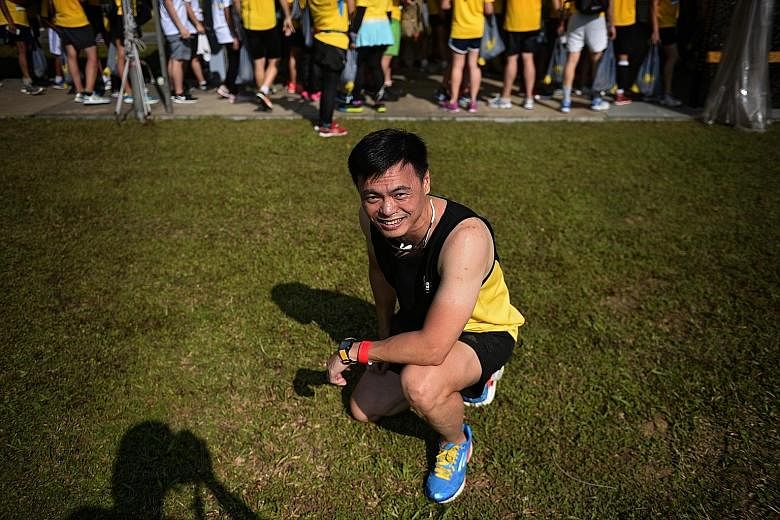At the crack of dawn on Sept 6, 2009, 40-year-old Jimmy Lee slipped on his running shoes and joined about 6,000 runners as they wound past historical sites into the Changi Prison Complex.
The hilly terrain, dotted with several steep inclines, was challenging even for seasoned runners. But the casual runner was all smiles.
His spirits were high after learning that the 2009 run had exceeded its target of 5,000 participants.
"At that time, I wasn't sure if people would sign up for the run and if the community would even be supportive of such a cause," said the Superintendent of Prisons and organising chairman of the run in 2009, which was the first Yellow Ribbon Prison Run.
Since then, more than 65,000 people have retraced the 5km and 10km routes, which take them past the Johore Battery and Tanah Merah Prison into Changi Prison Complex. They include some 9,000 participants who turned up for the eighth run yesterday morning.
The turnout for the inaugural run had been a "true worry" for Supt Lee, now 47 and director of corporate communications and relations at the Singapore Prison Service (SPS). The Yellow Ribbon Project, an initiative to encourage the reintegration of former offenders into the community through activities like the run, was then in its early years, he noted.
In an interview with The Straits Times last week, Supt Lee counts the run as one of the highlights of his career of 21 years with the SPS.
He started as a housing unit officer at the Drug Rehabilitation Centre (DRC) in 1996, fresh out of the National University of Singapore with a political science and history degree. He simply "needed a job", he said, but a career talk by a prison officer changed his perspective.
He said: "Back then, joining the army or the police force were popular choices if you wanted to join the uniformed service." But he said being a prison officer offered him the chance to contribute to society in a unique and meaningful way.
In his first three years, he interacted with inmates daily in the DRC. Some shared about their lack of family support, which often led them to return to their drug addictions. Others wondered if society would be willing to accept former offenders, especially in the workplace.
"I realised that community support was key in ensuring that the inmates don't become victims of incarceration," he said.
In 2009, he led a team of about 30 prison officers to organise the first Yellow Ribbon Prison Run to boost awareness of the broader Yellow Ribbon movement.
They spent several months mapping out possible routes and venues, including opening up the maximum-security Changi Prison Complex for the run and a carnival. This required a major change in mindset by the prison service, he said, as many viewed the prison compound as "insular and enclosed".
Said Supt Lee: "But if we wanted the community to accept ex-offenders, we can't have the doors remain closed. It was essential to bring the public closer to the work we do."
The race route carried another symbolic meaning, he said. "It has about nine inclines and declines and it's not easy, but it signifies the difficult journey faced by ex-offenders upon their release."
The team spent weeks talking to residents affected by multiple road closures. "Of course, we also took the chance to invite them to run with us," said Supt Lee with a laugh.
Superintendent of Prisons Soh Beng Koon, 42, who worked with him in the first run as vice-chairman, said: "Jimmy embraced the challenges that came along. He was open to ideas and he led with a clear vision of what the run should be."
While Supt Lee is no longer so involved in the run, watching it grow in size and support over the years gives him a sense of satisfaction.
"I never imagined that the run would be able to mobilise the community in this way, such that we have a core group of runners returning every year," he said.
In 2014, he signed up his daughters, then aged 12 and 14, for the 5km fun walk. It was their first time in the Changi Prison Complex and they were full of questions, he said. They later realised that "the prison was not a scary place and the ex-offenders were just like you and me".
Two months ago, as he passed by the void deck of his Housing Board block in Toa Payoh, he felt someone staring at him. The man grinned and called out: "Hi, Sir!" The man, in his late 40s, had been working as a cleaner since his release from prison about five years ago.
Supt Lee said: "We talked about his wife and two children, and I was glad to hear that he's doing well.
"It was touching how he openly called out to me, instead of shying away because of his past. It's a simple action but it keeps me going."


